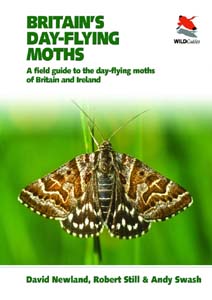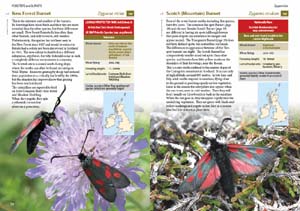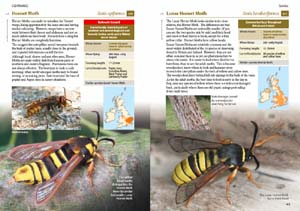by David Newland, Robert Still and Andy Swash
From the publisher: This concise photographic field guide will help you identify any of the 155 day-flying moths found in Britain and Ireland. Combining stunning photographs, authoritative text, and an easy-to-use design, this book makes a perfect traveling companion--one that will increase your enjoyment of these colorful and intriguing creatures. Like butterflies, some moths fly regularly in sunshine, whereas others that usually fly only at night are readily disturbed from their resting places during the day. This guide describes all of these species, with at least one photograph of each in its natural, resting pose. The text includes a brief description of each moth, with details of its life history, where and when to look for it, its status, the food plants of its caterpillars, and its special features. Introductory sections cover many topics, including how to distinguish moths from butterflies; classification; life cycle and behavior; ecological importance; the impact of habitat and climate change; recording and monitoring; and conservation.
 |
David Newland is the author of Discover Butterflies in Britain and the coauthor of Britain's Butterflies. Robert Still, the cofounder of WILDGuides, has designed more than thirty of its titles, and is the coauthor of Britain's Butterflies and Britain's Sea Mammals. Andy Swash, the managing director of WILDGuides, is the coauthor of Britain's Butterflies and Britain's Dragonflies (all WILDGuides).
Mike is the webmaster of Hants Moths and is the Micro-Moth Recorder for the Hampshire and Isle of Wight branch of Butterfly Conservation. Pete is the UK Butterflies webmaster and Chairman of the Hampshire and Isle of Wight branch of Butterfly Conservation.
Just when you think there isn't a gap in the market of Lepidoptera books to be filled, the WILDGuides team pull another trick out of the bag - this time, with a book that focuses purely on the day-flying moths of Britain and Ireland. This is no simple task given the potential number of moths, and it's therefore not surprising that the book runs to 224 pages covering 155 species (133 species of macro-moth and 22 species of micro-moth). The truth is, there are significantly more day-flying moths in the British Isles than there are butterflies, yet they are often overlooked by the naturalist. This guide seeks to address that by providing detailed descriptions of the 155 species deemed most likely to to be encountered by day.
The species accounts are organised by group, where a group represents either a family (such Sesiidae, the Clearwings) or a collection of families (such as "Tussocks, Footmen, Tigers and Ermines") and a comprehensive introduction to each group is provided. Each species is described on a single page with notes on distribution, conservation status, abundance, size, preferred habitat types, flight period, larval foodplants and confusion species. The book also has useful summaries of such subjects as taxonomy, biology and conservation. The authors should therefore be congratulated for managing to present so much information in such a compact form - the essence of a good field guide. The quality of the photography is generally excellent and attractively laid out, for the macros in particular. A minor annoyance is that some photographs are taken on egg boxes or skirting boards when this is a field guide.
 |
The choice of species is generally good, although this will always by necessity be something of a subjective choice. The inclusion of photos of the larger hawk-moths which "may be found resting by day" (not by us we have to say) is a trifle odd and are included more perhaps because they are spectacular than day-flying? In fact, several other species, most significantly Copper Underwing agg., Old Lady and the spectacular Herald (the most glaring of omissions), all of which hibernate in cool places such as cellars and sheds, are far more likely to be encountered and if the house- and clothes-moths are to be included, then these are equally eligible. Only one significant error was spotted - the Latticed Heath shown on p.109 isn't; it is a female Common Heath.
 |
We appreciate that the book attempts to serve as an introduction to micros and is in no way intended to be a comprehensive guide, and in that respect it generally serves its purpose. However, as this is a field guide, the choice of the 22 species for which full accounts are written is a little random: while the common Adela reaumurella is a worthy choice, the casual observer is more likely to notice the gold-striped Nemaphora degeerella in a walk in the woods or Adela croesella on downland scrub. The widespread but not particularly numerous Glyphipterix thrasonella is included but not the abundant G. simpliciella which can be seen swarming over buttercups in meadows throughout (the same can be said for Micropterix calthella, also absent). Leaf-mines, in particular that of the tiny Stigmella aurella, which is ubiquitous on bramble, would also have been an essential part of any general overview of micros.
The use of invented common names is regrettable which some will see as a minor point. Some names, like "Spindle Ermine", are widely used, but the use of names such as Speckled Fanner, Arched Marble or Feathered Bright, however, will most-likely cause any self-respecting county recorder to roll their eyes!
Grouches aside, the book certainly lives up to WILDGuides' own very high standards and is a welcome addition to the lay naturalist's library. It ably demonstrates that the separation of moths and butterflies is an artificial one and will make any outing in the field more enjoyable, particularly for those who focus only on butterflies. We believe that this book will become an essential item in a transect walker's rucksack and will undoubtedly contribute to the awareness and monitoring of day-flying moths. As such, it is highly recommended.
The book costs £17.95 and can be ordered from the Princeton University Press website.